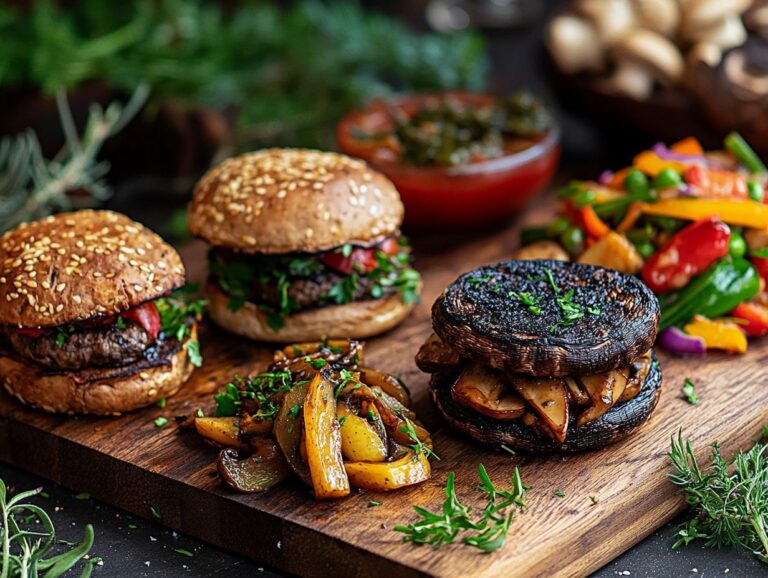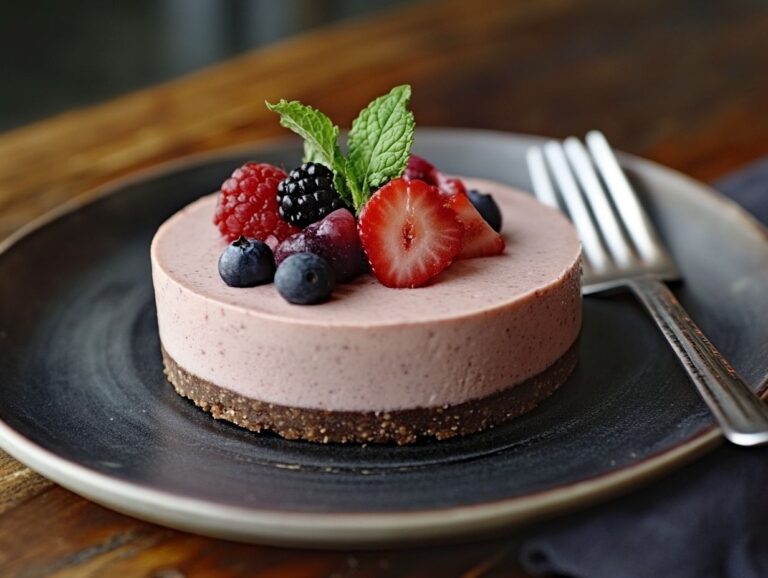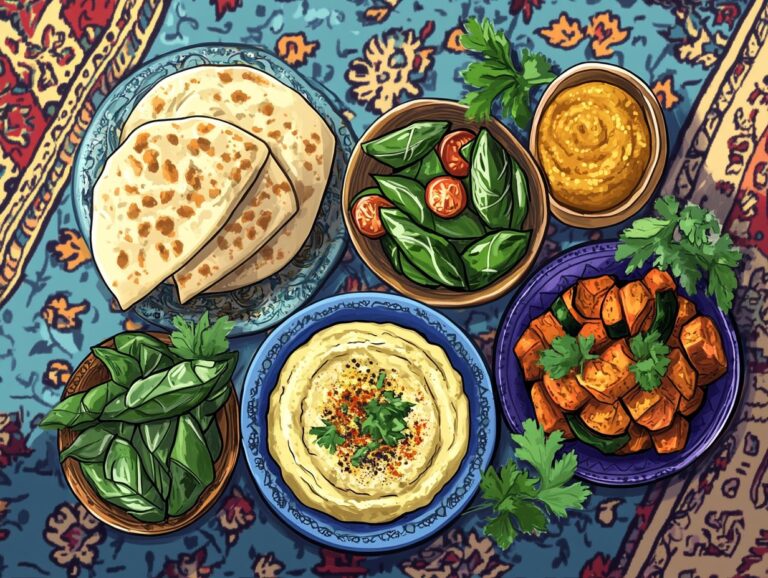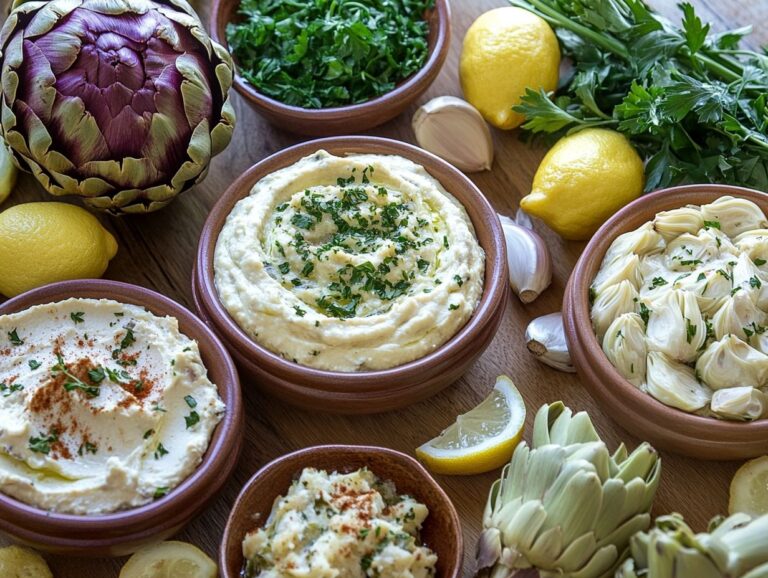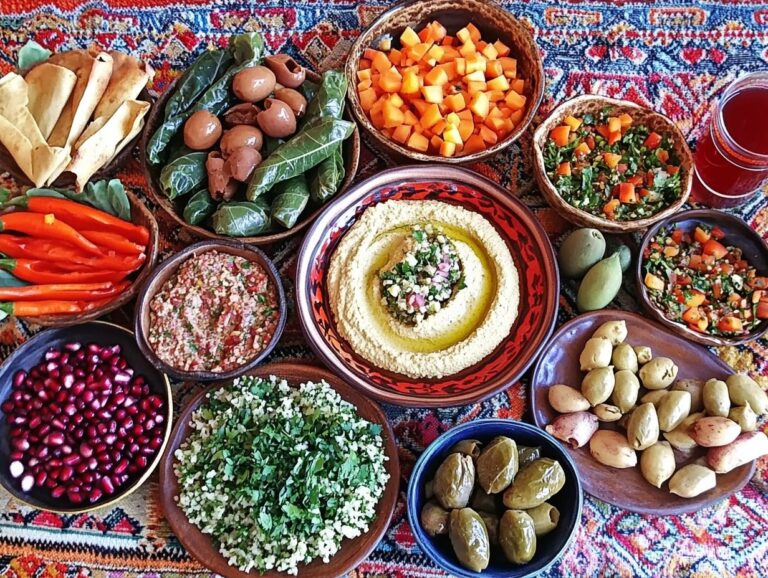This article explores the world of raw vegan dehydrator recipes, highlighting the nutritional benefits of raw foods and their potential as healthy, gluten-free, and nutritious snacks. You will find a guide to essential ingredients for your raw vegan pantry, along with recommended dehydrator models. Additionally, the article provides easy-to-follow recipes for delicious options such as raw vegan granola bars and kale chips. Finally, we will share valuable tips for successfully adopting a raw vegan lifestyle.
What is a Raw Vegan Diet?
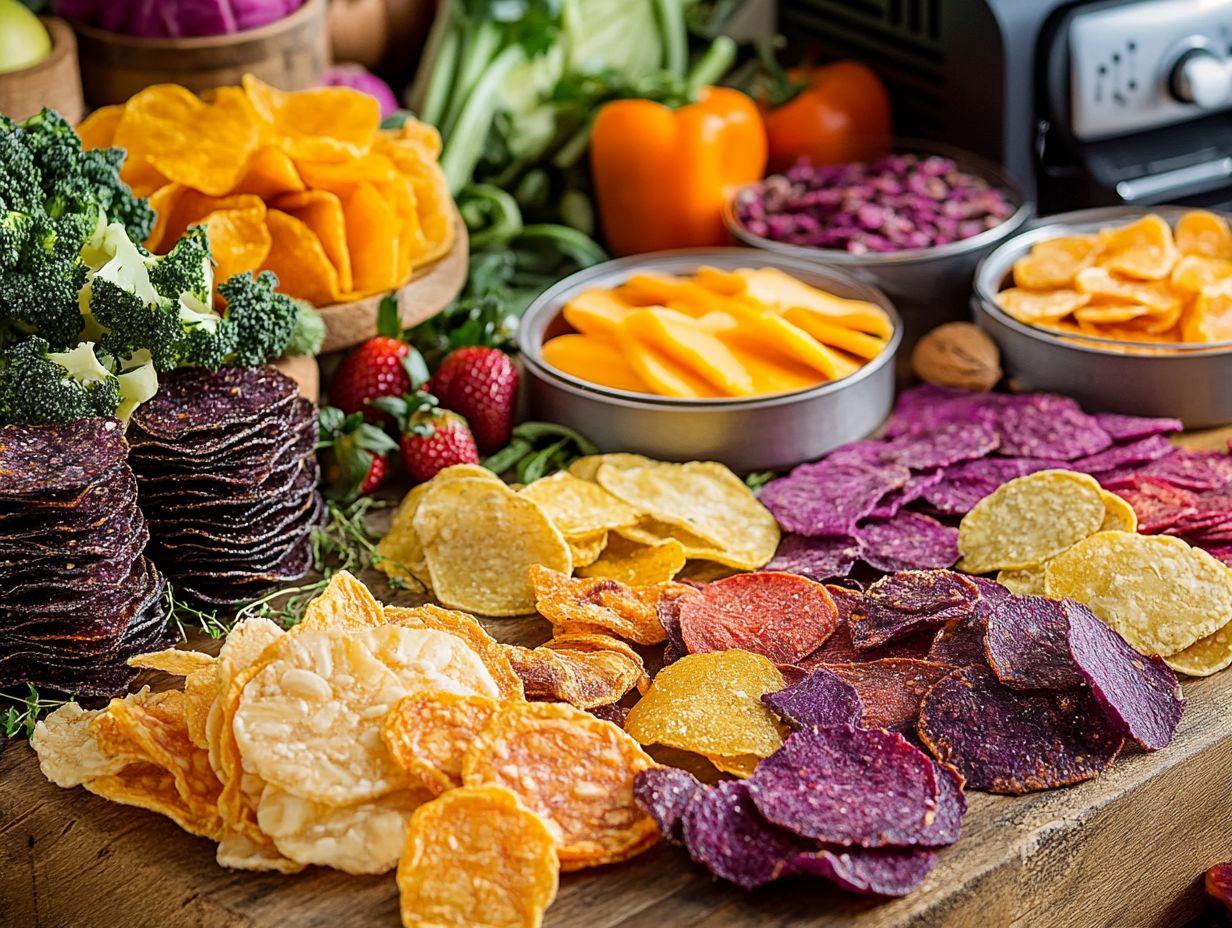
A Raw Vegan Diet is a lifestyle choice that merges the principles of veganism with the consumption of raw foods, which are unprocessed, uncooked, and naturally gluten-free and low-fat. This diet focuses on whole foods that are nutrient-dense and rich in natural flavors.
It emphasizes the intake of fruits, vegetables, seeds, nuts, and grains in their natural state, promoting health benefits associated with fresh produce and organic ingredients. Adopting a raw vegan diet can contribute to a healthier lifestyle while fostering a connection to sustainable eating practices.
By embracing this dietary approach, individuals often enjoy a variety of salads, smoothies, and raw soups, showcasing the diverse flavors and textures that whole foods can offer. This vibrant cuisine nourishes the body and aligns with environmental consciousness, as it frequently relies on locally sourced, seasonal ingredients, reducing the carbon footprint.
Numerous studies suggest that following a raw vegan diet can enhance energy levels, aid digestion, and promote weight management, highlighting its potential as a holistic approach to health and wellness.
The emphasis on living foods fosters a deeper appreciation for what nourishes the body and encourages a more mindful way of eating.
Benefits of Raw Vegan Dehydrator Recipes
Raw vegan dehydrator recipes promote healthy eating by enabling individuals to create delicious, nutrient-rich snacks from fresh produce.
These dehydrator recipes are easy to prepare and store, while preserving the natural flavors and health benefits of the ingredients, making them ideal for quick snacks and meal prep.
Dehydrators can be used to make a variety of convenient snacks, such as:
- Vegetable chips
- Fruit leather
- Zucchini chips
- Energy bars
All of which can be incorporated into a balanced diet that emphasizes whole foods and low-calorie, nutrient-dense meals. Such recipes cater to those following a raw food lifestyle.
Nutritional Advantages of Raw Foods
The nutritional benefits of raw foods are substantial, as they are often rich in vitamins, minerals, antioxidants, and enzymes that promote health and well-being, making them an essential component of a raw vegan diet. Foods such as fresh fruits, vegetables, nuts, and seeds retain more nutrients than cooked foods, ensuring that individuals receive maximum health benefits while consuming low-calorie options.
By choosing raw foods, individuals can enjoy a diet that is both flavorful and nutrient-dense, aligning with a healthy and sustainable lifestyle.
The nutritional advantages of raw foods include the following:
- Consuming raw foods improves digestion and metabolic efficiency due to the presence of digestive enzymes, which are often destroyed during cooking.
- Raw foods are low in calories and high in fiber, aiding in weight management while enhancing satiety and appetite control.
- These foods are rich in antioxidants, which help reduce oxidative stress and lower the risk of chronic diseases, contributing to a more energetic and vibrant lifestyle.
Convenience and Portability
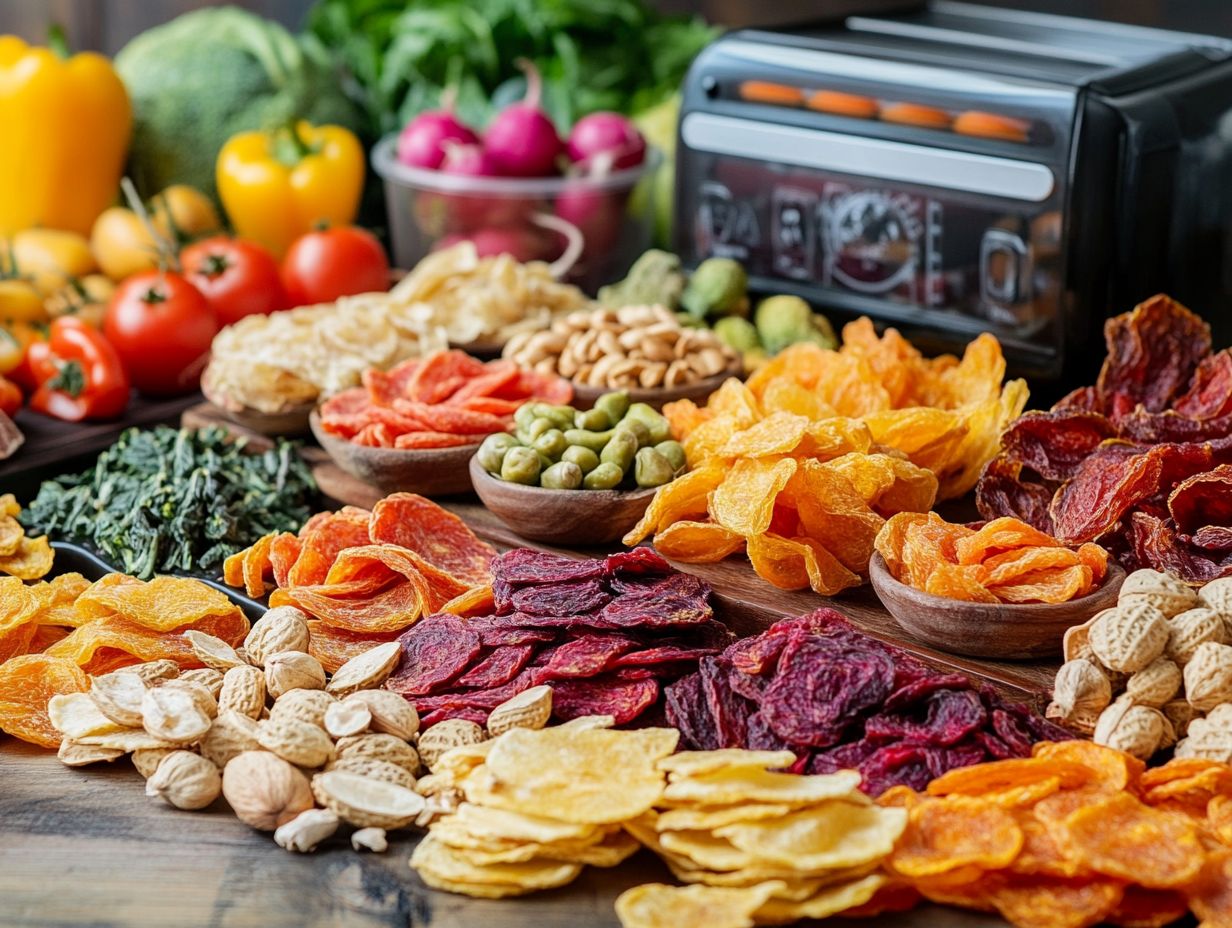
One of the advantages of raw vegan dehydrator recipes is their ease and speed of preparation, making them ideal healthy snacks for school and travel.
These dehydrated snacks, such as nut mixes, kale chips, zucchini chips, and seed crackers, can be made in batches and stored conveniently. They are often among the quickest raw vegan recipes since they require no actual cooking and very few kitchen gadgets.
This simplicity allows for easier meal prep and fosters healthy eating without sacrificing taste or nutrition.
Ingredients and Tools for Raw Vegan Dehydrator Recipes
Delicious raw vegan dehydrator recipes are crafted using essential ingredients and the right appliances, particularly a high-quality dehydrator that facilitates the food dehydration process.
It is important to understand the basic ingredients—such as fresh produce, nuts, seeds, and natural sweeteners—as well as the proper dehydration process and culinary techniques to retain their nutritional value in order to create flavorful snacks like energy bars and fruit snacks.
With the right tools and ingredients, home cooks can explore their culinary creativity and enjoy a diverse array of raw snacks.
Essential Ingredients for a Raw Vegan Pantry
A well-stocked raw vegan pantry should include a variety of whole foods and organic ingredients that support the preparation of dehydrator recipes while promoting a healthy, plant-based lifestyle.
Key ingredients to consider are:
- Raw nuts
- Seeds
- Dried fruits
- An assortment of vegetables that can be creatively transformed into savory snacks, crunchy treats, or flavorful energy bars.
This diverse selection ensures that home cooks have everything they need to whip up simple, nutritious, and satisfying recipes.
For example, incorporating ingredients like coconut flakes and nutritional yeast can enhance the flavor and texture of various dehydrated dishes, ranging from granola to veggie crisps and savory snacks. Additionally, spices such as cumin, paprika, and garlic powder can elevate the taste profile, transforming ordinary vegetable chips into a gourmet experience.
Fresh herbs, though not dehydrated, can also be included for added freshness and flavor. Storing a variety of whole grains, such as quinoa and buckwheat, provides a nutritious base for raw salads and bowls. Together, these ingredients not only enrich the raw vegan pantry but also inspire creativity in the kitchen.
Recommended Dehydrator Models
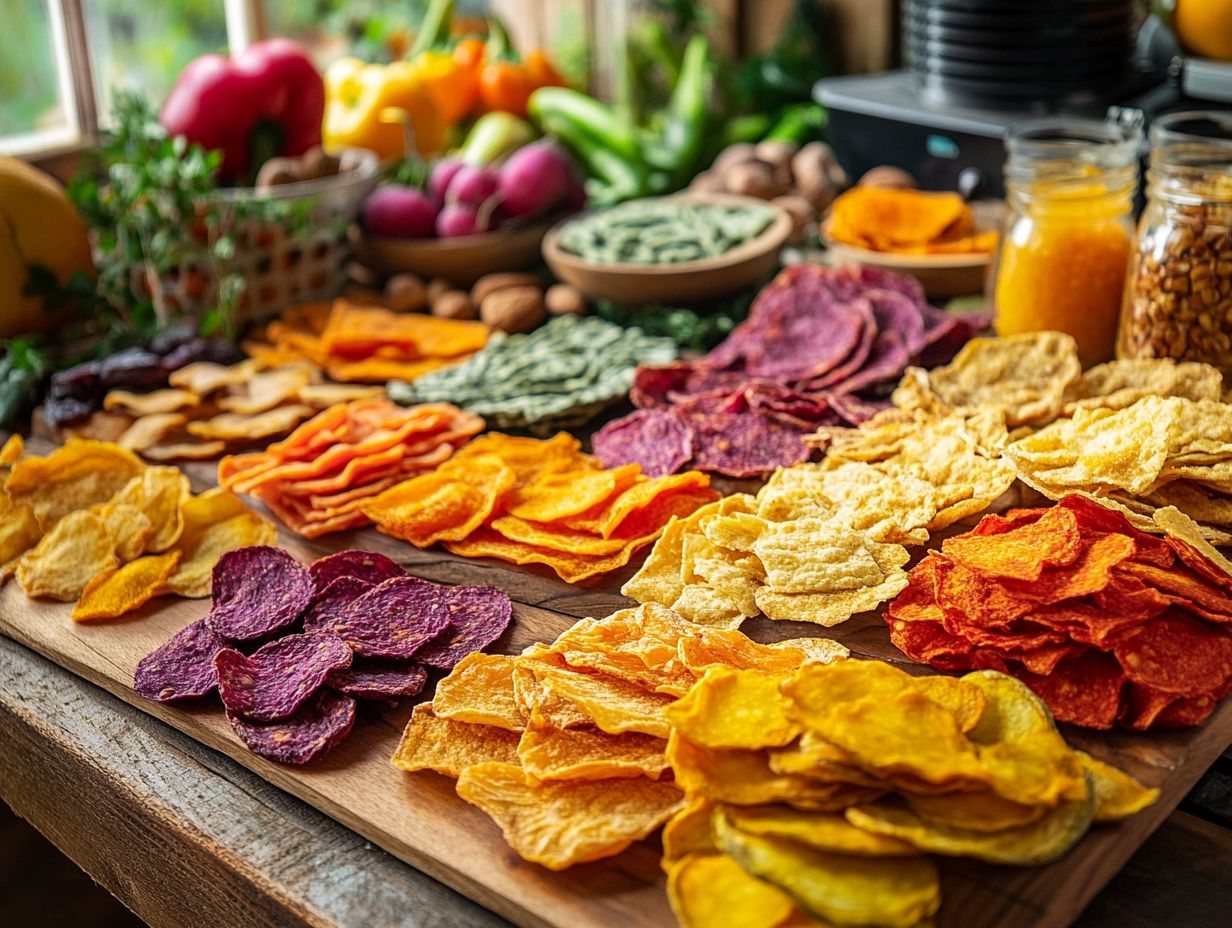
Choosing the right dehydrator model for food dehydration is essential, as different models offer varying levels of efficiency, temperature control, and capacity for producing high-quality raw vegan snacks.
Popular food dehydrators typically feature adjustable temperature settings and spacious trays that accommodate large quantities of fruits and vegetables for simultaneous drying.
These models are suitable for creating a variety of snacks, from vegetable chips to raw fruit leather and homemade treats. Reliable dehydrators enable home cooks to maximize their culinary creativity while reaping the health benefits of dehydrated foods.
Some dehydrators come equipped with advanced digital interfaces, making it easy to monitor and adjust the dehydration process, enhancing food safety and efficiency. These user-friendly appliances often include timers and automatic shut-off features for added convenience.
For those adhering to a raw vegan diet, certain models are particularly effective at preserving the nutrients and enzymes in food, ensuring that every batch of dried fruits and vegetables is bursting with flavor and nutritional value.
Whether experimenting with new recipes or simply making snacks, selecting a model that meets your needs will enhance the overall experience of food dehydration.
Easy and Delicious Raw Vegan Dehydrator Recipes
Some of the best and most delicious raw vegan dehydrator recipes include snacks like granola bars, kale chips, and fruit leather. These recipes serve as a foundation for cultivating a diverse range of culinary creativity that satisfies the craving for tasty raw vegan food.
Those looking to customize their flavors and meet specific nutritional needs can modify these simple raw vegan dehydrator recipes by incorporating different tastes, textures, and ingredients, including superfoods and natural ingredients.
Raw Vegan Granola Bars
Raw vegan granola bars are an energy-packed snack that combines nutritious ingredients in an easy-to-make recipe, offering both nutrition and flavor. These bars are crafted from raw nuts, seeds, and dried fruits and can be tailored to various flavor profiles to suit individual tastes while remaining delicious.
They serve as a convenient plant-based, allergen-free raw snack and are perfect for meal prep, making them a popular choice for healthy eating on the go. Typically, the bars are made in a food processor by combining the ingredients and mixing them until they stick together.
Commonly used ingredients include:
- Almonds
- Walnuts
- Chia seeds
- Dried apricots or dates
These ingredients not only add sweetness but also provide essential nutrients such as fiber and healthy fats. To create customized versions of these healthy snacks, you can incorporate various spices like cinnamon and vanilla extract, or superfoods such as cacao nibs and hemp seeds.
Packed with energy and high-protein ingredients, granola bars make an excellent breakfast, a quick midday snack, or a nourishing pre-workout option.
Raw Vegan Kale Chips
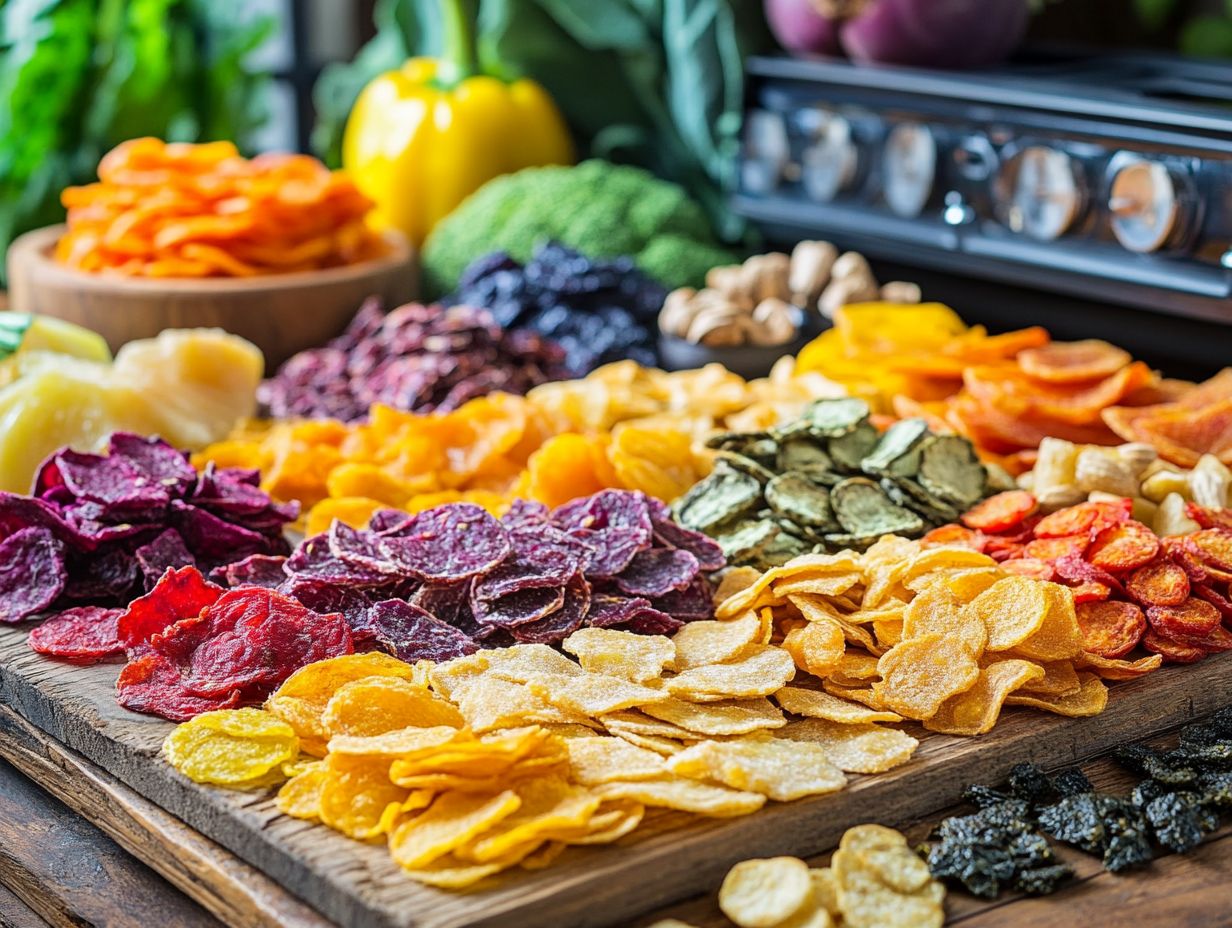
Raw vegan kale chips are a savory snack that offers a healthy and delicious alternative to traditional chips. The dehydration process enhances the flavor profiles of the kale leaves while preserving essential nutrients, making them an ideal choice for those pursuing a nutritious diet.
By incorporating various spices and seasonings, home cooks can create diverse flavor enhancements that appeal to a wide audience. These appetizing snacks are not only tasty but also packed with vitamins A, C, and K, as well as antioxidants that promote overall well-being.
To elevate the taste further, consider adding:
- Nutritional yeast for a cheesy flavor
- Garlic powder for a spicy kick
- A sprinkle of smoked paprika for an irresistible depth
Kale chips are versatile and easy to prepare, making them a perfect plant-based and gluten-free option. They allow for customization to suit individual preferences and can be enjoyed on their own or crumbled on top of salads. Consider pairing them with zucchini chips for a varied and healthy snack platter.
Raw Vegan Fruit Leather
Raw vegan fruit leather is a fun and healthy alternative to store-bought snacks, celebrated in the realm of wholesome, plant-based treats. Made from pureed fruits and natural sweeteners, they create a chewy, flavorful delight that is fiber-rich and packed with vitamins and minerals. This easy-to-make recipe allows for a variety of fruit combinations, giving individuals the creative opportunity to experiment with different flavors while enjoying the benefits of fresh produce. Perfect for both kids and adults, fruit leather is a nutrient-dense snack that promotes healthy eating habits and supports a raw food diet.
Raw Vegan Fruit Leather Recipe
Difficulty: Easy
Servings: 8-10 pieces
Ingredients:
- 3 cups of seasonal fruit puree (e.g., strawberries, mango, apples, peaches, pears)
- 1-3 tbsp (15-45 mL) maple syrup or agave nectar (optional)
- 1 tsp (5 mL) lemon juice (optional)
Equipment:
- Dehydrator
- Oven
- Parchment paper
- Baking sheet or dehydrator tray
- Storage container
Instructions:
- Choose the right fruits: Select ripe, seasonal fruits that will enhance the flavor and nutritional value of the fruit leather.
- Prepare the fruits: Wash, chop, and remove any seeds or pits from the fruits.
- Blend into puree: Add the prepared fruits to a blender and blend until smooth.
- Sweeten if necessary: Taste the fruit puree and add maple syrup or agave nectar if you desire more sweetness. This step can be omitted if the fruits are sweet enough on their own.
- Add lemon juice (optional): Incorporate lemon juice for a tart flavor and to help preserve the color of the fruit leather.
- Prepare the drying surface: Line baking sheets or dehydrator trays with parchment paper.
- Spread the mixture: Pour the fruit puree evenly onto the prepared surfaces.
- Dry in the dehydrator: If using a dehydrator, set it to the lowest temperature and dry for 6-8 hours, or until the mixture is no longer sticky.
- Dry in the oven: For oven drying, set the oven to the lowest temperature and prop the oven door open to allow moisture to escape. Dry for 6-8 hours.
- Test for doneness: The fruit leather is ready when it is no longer sticky and peels off easily from the parchment paper.
- Store: Cut into strips, roll in parchment paper, and store in an airtight container in the refrigerator for up to a month.
Tips for Success with Raw Vegan Dehydrator Recipes
The most effective tips and techniques for raw vegan dehydrator recipes focus on achieving successful results, including flavor enhancement, nutrient preservation, and proper storage practices that extend shelf life. Incorporating superfoods and fresh herbs or spices can elevate gourmet snacks and contribute to a balanced snack culture.
Understanding how to store dehydrated snacks can significantly prolong their freshness, while following specific dehydration processes can enhance both flavor and nutrient retention.
Implementing these best practices allows home cooks to enjoy the benefits of these delicious and healthy snacks for an extended period.
Proper Storage and Shelf Life
Proper storage and an understanding of the shelf life of dehydrated snacks, such as vegetable crisps and dried fruit, are essential for maintaining the quality and safety of raw vegan recipes. This ensures that nutritious options remain both delicious and safe for consumption, supporting a healthy lifestyle and sustainable eating habits.
Utilizing airtight containers and storing snacks in cool, dark areas helps preserve the flavors and nutrients in dehydrated foods, promoting a healthy lifestyle through effective food preservation. By prioritizing food safety, individuals can enjoy their homemade snacks for extended periods without compromising quality.
To further enhance the longevity of these delightful treats, consider using glass jars or vacuum-sealed bags, as they provide superior protection against moisture and air exposure, crucial for preserving snacks like granola and vegetable crisps. It is also crucial to store snacks away from direct sunlight and fluctuating temperatures, as these factors can lead to rapid deterioration, ensuring your homemade treats remain enjoyable and nutritious.
Regularly checking for signs of spoilage, such as unusual odors or changes in texture, ensures that any compromised snacks are discarded promptly, safeguarding both health and enjoyment. Understanding these practices significantly contributes to maximizing shelf life while preserving taste.
Variations and Substitutions
Incorporating variations and substitutions in raw vegan recipes enables home cooks to tailor flavors and ingredients to their personal taste preferences or dietary requirements. Experimentation with ingredient substitutions like using nuts and seeds for added protein or trying gluten-free alternatives can open up new snack ideas and creative cooking opportunities.
For instance, using almond flour instead of traditional flour can introduce a delightful nutty flavor. Agave syrup can be exchanged for maple syrup to enhance the sweetness in desserts, while spices such as smoked paprika or turmeric can be added to infuse unique flavors into raw salads and vegetable dips.
Additionally, creamy avocado can serve as an alternative to cashews, providing a smoother texture, and herbs like basil can replace parsley for a different aromatic profile.
